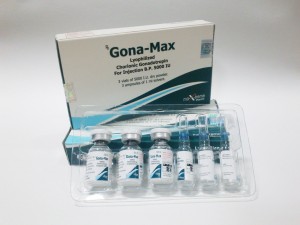 The action of HCG is virtually identical to that of pituitary LH, although HCG appears to have a small degree of FSH activity as well. It stimulates production of gonadal steroid hormones by stimulating the interstitial cells (Leydig cells) of the testis to produce androgens and the corpus luteum of the ovary to produce progesterone. Androgen stimulation in the male leads to the development of secondary sex characteristics and may stimulate testicular descent when no anatomical impediment to descent is present. This descent is usually reversible when HCG is discontinued. During the normal menstrual cycle, LH participates with FSH in the development and maturation of the normal ovarian follicle, and the mid-cycle LH surge triggers ovulation. HCG can substitute for LH in this function. During a normal pregnancy, HCG secreted by the placenta maintains the corpus luteum after LH secretion decreases, supporting continued secretion of estrogen and progesterone and preventing menstruation. HCG HAS NO KNOWN EFFECT ON FAT MOBILIZATION, APPETITE OR SENSE OF HUNGER, OR BODY FAT DISTRIBUTION.
The action of HCG is virtually identical to that of pituitary LH, although HCG appears to have a small degree of FSH activity as well. It stimulates production of gonadal steroid hormones by stimulating the interstitial cells (Leydig cells) of the testis to produce androgens and the corpus luteum of the ovary to produce progesterone. Androgen stimulation in the male leads to the development of secondary sex characteristics and may stimulate testicular descent when no anatomical impediment to descent is present. This descent is usually reversible when HCG is discontinued. During the normal menstrual cycle, LH participates with FSH in the development and maturation of the normal ovarian follicle, and the mid-cycle LH surge triggers ovulation. HCG can substitute for LH in this function. During a normal pregnancy, HCG secreted by the placenta maintains the corpus luteum after LH secretion decreases, supporting continued secretion of estrogen and progesterone and preventing menstruation. HCG HAS NO KNOWN EFFECT ON FAT MOBILIZATION, APPETITE OR SENSE OF HUNGER, OR BODY FAT DISTRIBUTION.
INDICATION
HCG has not been demonstrated to be effective adjunctive therapy in the treatment of obesity. there is no substantial evidence that it increases weight loss beyond that resulting from caloric restriction, that it causes a more attractive or ‘‘normal’’ distribution of fat, or that it decreases the hunger and discomfort associated with calorie-restricted diets.
- Prepubertal cryptorchidism not due to anatomical obstruction. In general, HCG is thought to induce testicular descent in situations when descent would have occurred at puberty. HCG thus may help predict whether or not orchiopexy will be needed in the future. Although, in some cases, descent following HCG administration is permanent, in most cases, the response is temporary. Therapy is usually instituted between the ages four and nine.
- Selected cases of hypogonadotropic hypogonadism (hypogonadism secondary to a pituitary deficiency) in males.
- Induction of ovulation and pregnancy in the anovulatory, infertile woman in whom the cause of anovulation is secondary and not due to primary ovarian failure, and who has been appropriately pretreated with human menotropins.



